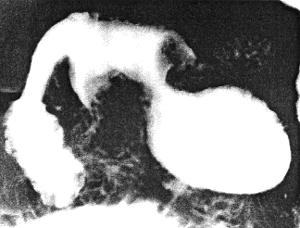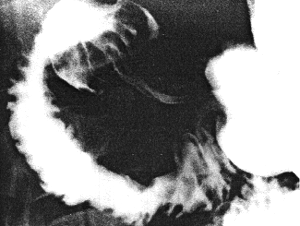


Go to chapter: 1 | 2 | 3 | 4 | 5 | 6 | 7 | 8 | 9 | 10 | 11 | 12 | 13 | 14 | 15 | 16 | 17 | 18 | 19 | 20 | 21 | 22 | 23 | 24 | 25 | 26 | 27 | 28 | 29 | 30 | 31 | 32 | 33 | 34 | 35 | 36 | 37 | 38 | 39
Chapter 38 (page 192)




Go to chapter: 1 | 2 | 3 | 4 | 5 | 6 | 7 | 8 | 9 | 10 | 11 | 12 | 13 | 14 | 15 | 16 | 17 | 18 | 19 | 20 | 21 | 22 | 23 | 24 | 25 | 26 | 27 | 28 | 29 | 30 | 31 | 32 | 33 | 34 | 35 | 36 | 37 | 38 | 39
Chapter 38 (page 192)
A | |
B |
Fig. 38.3 A,B. Case M.W. A Partial contraction of sphincteric cylinder. Shallow, concave indentation base of duodenal bulb. B Case M.W. Maximal contraction of cylinder. Umbrella-like defect base of bulb continuous with longitudinal mucosal folds in pyloric canal |
Previous Page | Table of Contents | Next Page
© Copyright PLiG 1998